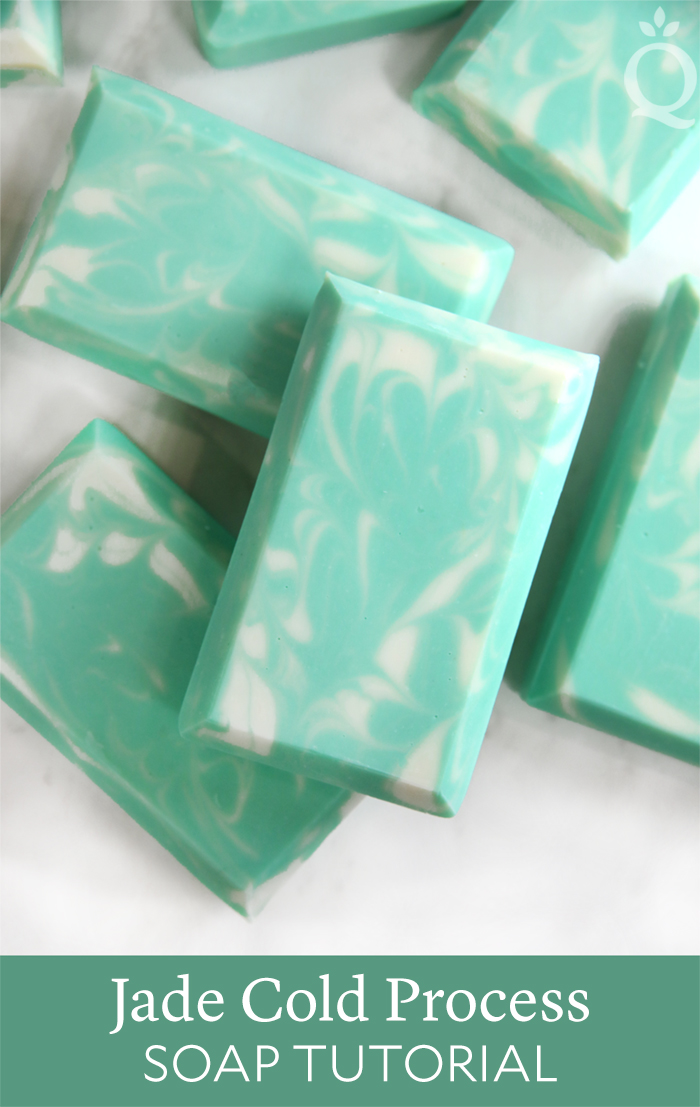
The jade stone is known for its beautiful green color and the thought that it has healing properties. The stone inspired our Jade Fragrance Oil, which is a fresh and green floral scent. It has notes of English ivy, jasmine, green apple, and neroli. The wispy swirls in these jade bars are created by pouring the green and white soap into the mold, then swirling them together with the Hanger Swirl Tool.
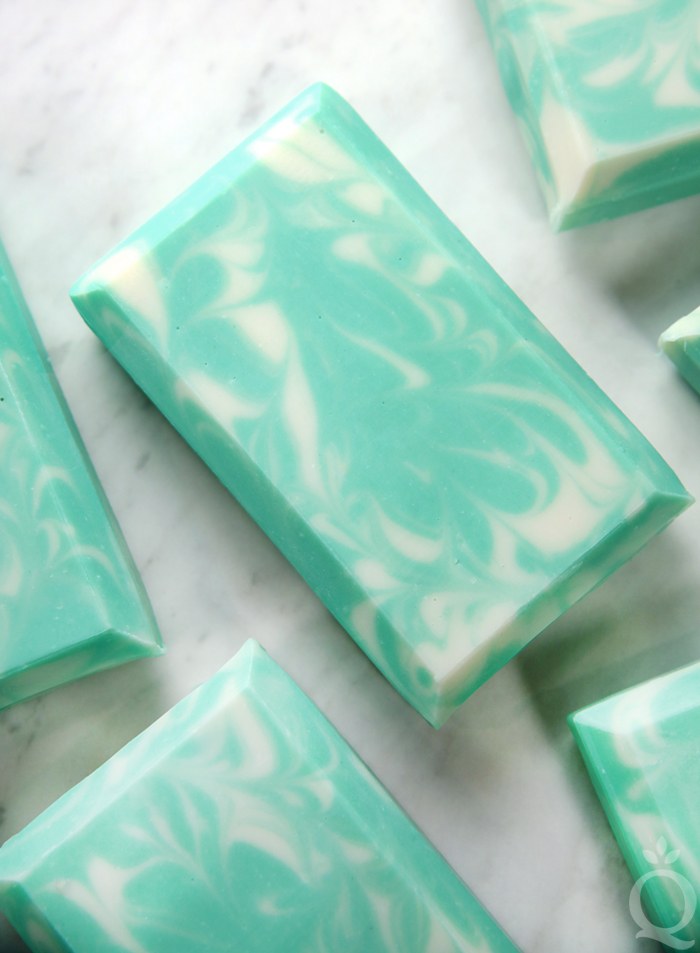
The great thing about this project is there are no concrete rules on how to create the swirls. You can pour the green and white soap with lots of layers or just a few. You can also experiment with moving the Hanger Swirl Tool in different directions and frequency. Each bar looks completely unique. Jade Fragrance Oil allows for plenty of time to swirl the soap, making it ideal for cold process beginners. This soap has a 10% water discount to help prevent glycerin rivers.
What You Need: Click below to add everything you need for this project to your Bramble Berry shopping cart!Jade Cold Process Soap Tutorial
Tall Narrow Wood Loaf Mold
Hanger Swirl Tool
3.2 oz. Borage Oil (8%)
1.2 oz. Castor Oil (3%)
10 oz. Coconut Oil (25%)
17.6 oz. Olive Oil (44%)
8 oz. Palm Oil (20%)
5.6 oz. Sodium Hydroxide Lye
11.9 oz. Distilled Water (10% water discount)
2 oz. Jade Fragrance Oil
Titanium Dioxide
Aqua Pearl Mica
Kelly Green Mica
If you’ve never made cold process soap before, stop here. Check out our FREE four part SoapQueen.tv series on cold process soapmaking, especially the episode on lye safety. Bramble Berry also carries a wide range of books on the topic, including Pure Soapmaking.
COLOR PREP: Disperse 1 teaspoon Aqua Pearl Mica into 1 tablespoon of lightweight liquid oil (like sunflower or sweet almond oil). In a separate container, disperse 1/2 teaspoon Kelly Green Mica into 1/2 tablespoon lightweight liquid oil. Use a mini mixer to get out any clumps.
FRAGRANCE PREP: Measure 2 ounces of Jade Fragrance Oil into a small glass container. Set aside.
MOLD & TOOL PREP: Line the Tall Narrow Wood Loaf Mold with freezer paper with the shiny side up. For tips on how to line the mold, click here. Bend your Hanger Swirl Tool so it fits the mold perfectly by length.
SAFETY FIRST: Suit up for safe handling practices. That means goggles, gloves, and long sleeves. Make sure kids, pets, and other distractions and tripping hazards are out of the house or don’t have access to your soaping space. Always soap in a well-ventilated area.
ONE: Slowly and carefully add the lye to the water and gently stir until the lye has fully dissolved and the liquid is clear. Set aside to cool. If you’d like a harder bar of soap that releases faster from the mold, you can add sodium lactate to the cooled lye water. Use 1 teaspoon of sodium lactate per pound of oils in the recipe. For this recipe, you’d add 2.5 teaspoons sodium lactate.
TWO: Melt and combine the coconut oil, palm oil, olive oil, borage oil, and castor oil (remember to fully melt the entire amount of palm oil before measuring) in a large bowl capable of holding at least 60 ounces. Add 1.5 teaspoons of titanium dioxide powder directly into the oils and use the stick blender to help get rid of clumps. We added the titanium dioxide directly to the oils so we could stick blend out the clumps as much as possible without the trace becoming too thick.
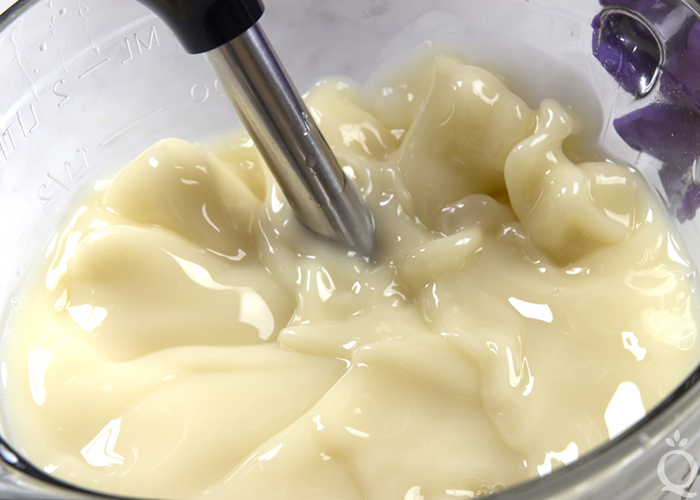 THREE: Once the lye water and the oils have cooled to 130 degrees F or below (and are ideally within 10 degrees of each other), add the lye water to the oils and stick blend until thin trace.
THREE: Once the lye water and the oils have cooled to 130 degrees F or below (and are ideally within 10 degrees of each other), add the lye water to the oils and stick blend until thin trace.
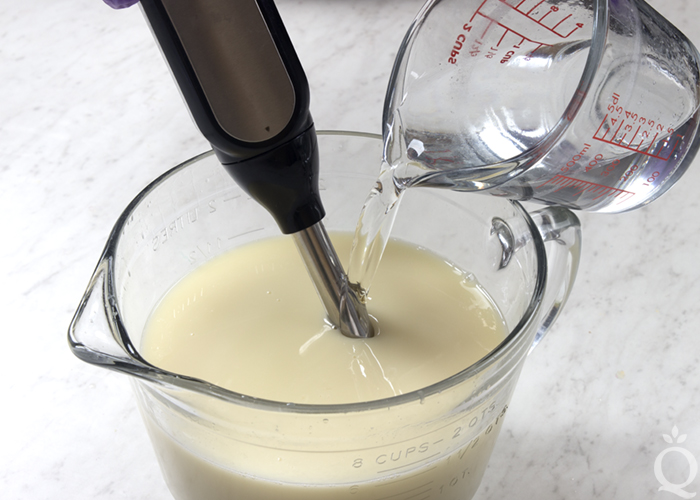
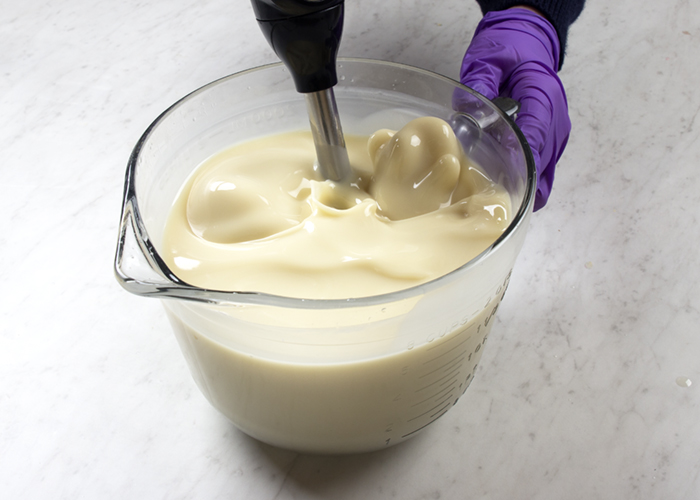 FOUR: Add all of the Jade Fragrance Oil to the soap batter and use a whisk to thoroughly mix in.
FOUR: Add all of the Jade Fragrance Oil to the soap batter and use a whisk to thoroughly mix in.
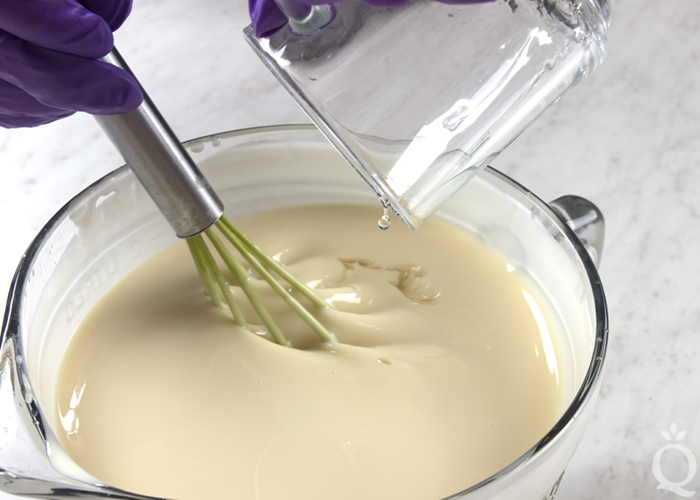 FIVE: Split off about 500 mL of soap into a smaller container. Then add all of the dispersed Aqua Pearl Mica and 1 teaspoon of the Kelly Green Mica to the larger container of soap. Use a whisk to thoroughly mix in the colorants.
FIVE: Split off about 500 mL of soap into a smaller container. Then add all of the dispersed Aqua Pearl Mica and 1 teaspoon of the Kelly Green Mica to the larger container of soap. Use a whisk to thoroughly mix in the colorants.
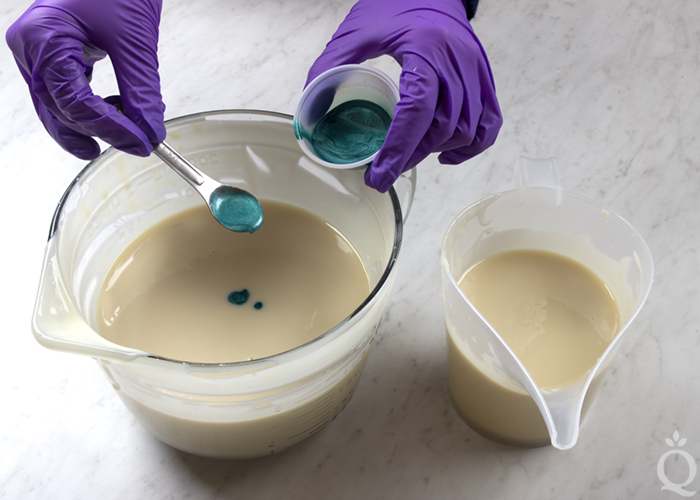
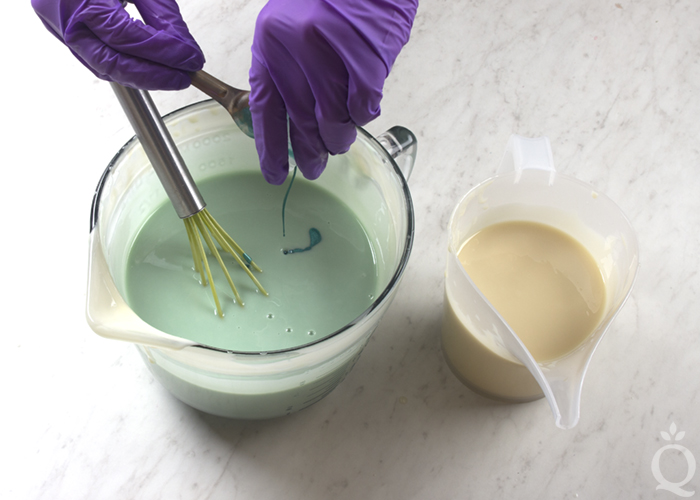 NOTE: The soap batter should be a thin enough texture to pour but thick enough that the colors don’t completely blend together. If the batter is a little thin, pulse both containers quickly with the stick blender to slightly thicken. Just be careful to not over stick blend.
NOTE: The soap batter should be a thin enough texture to pour but thick enough that the colors don’t completely blend together. If the batter is a little thin, pulse both containers quickly with the stick blender to slightly thicken. Just be careful to not over stick blend.
SIX: Pour some of the green soap into the mold. Then, pour the white soap into the green. Pour the white from several inches above the mold to help the white soap break into the green soap.
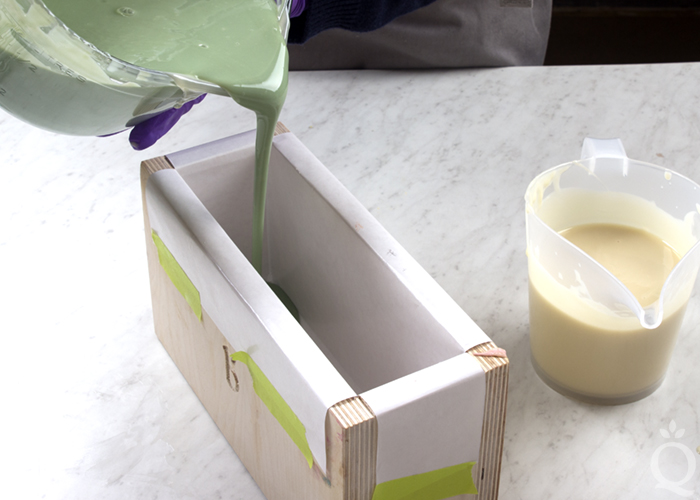
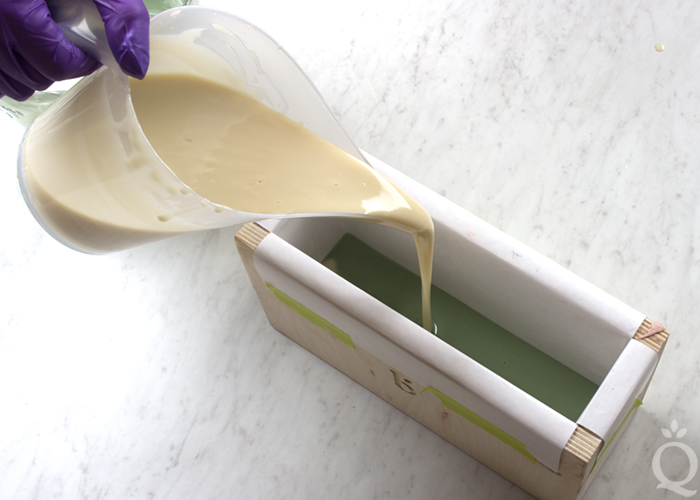 SEVEN: Continue pouring the green and white soap into the mold. The exact amount and placement of each pour is not extremely important. After every few pours, tap the mold on the counter to help get rid of bubbles. Whisk the soap throughout the process to keep it fluid.
SEVEN: Continue pouring the green and white soap into the mold. The exact amount and placement of each pour is not extremely important. After every few pours, tap the mold on the counter to help get rid of bubbles. Whisk the soap throughout the process to keep it fluid.
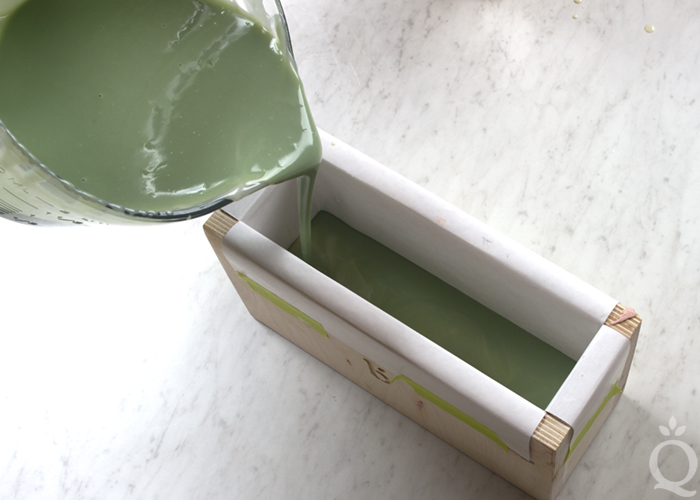
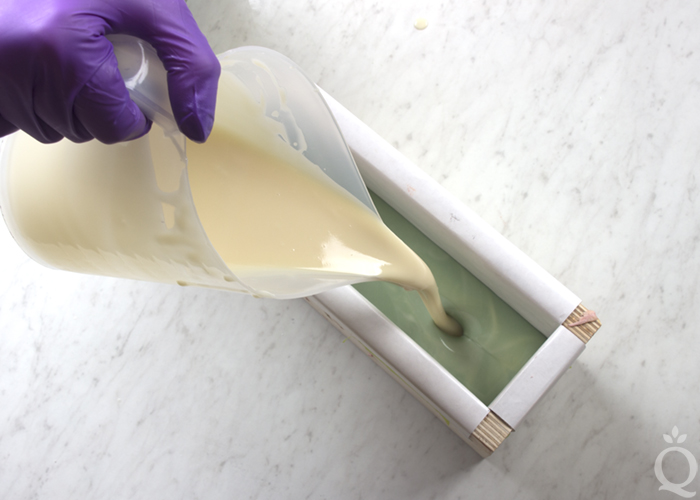 EIGHT: Once the soap is almost all poured into the mold, set aside a very small amount of green and white soap to create a swirl pattern on top.
EIGHT: Once the soap is almost all poured into the mold, set aside a very small amount of green and white soap to create a swirl pattern on top.
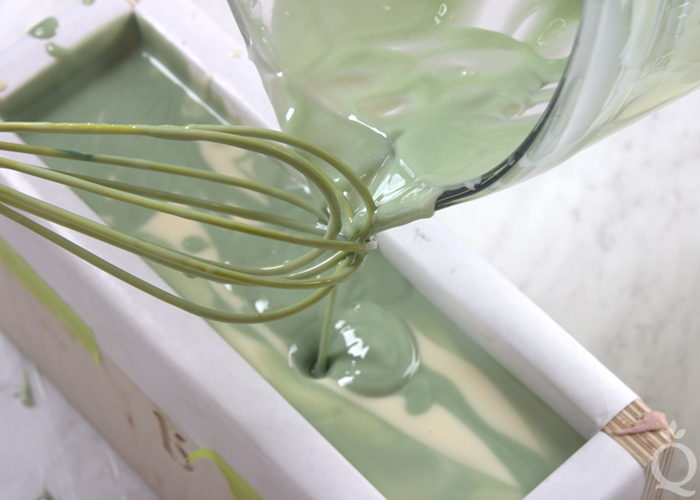 NINE: Give the mold a firm tap on the counter. Insert the Hanger Swirl Tool into one side of the mold, and begin making loops in the center of the mold. Continue the loop-de-loop motion at varying heights within the mold. This technique is not an exact science. We “looped” the Hanger Swirl Tool about 10 times within the mold. If you like more wispy swirls, feel free to do more loops.
NINE: Give the mold a firm tap on the counter. Insert the Hanger Swirl Tool into one side of the mold, and begin making loops in the center of the mold. Continue the loop-de-loop motion at varying heights within the mold. This technique is not an exact science. We “looped” the Hanger Swirl Tool about 10 times within the mold. If you like more wispy swirls, feel free to do more loops.
This technique is similar to the Butterfly Swirl created by Zahida of Handmade in Florida. See her video here to get a better idea of what that swirling motion looks like. We were much less precise in our swirl for this soap. Remove the Hanger Swirl Tool by pulling up and out along one side of the mold.
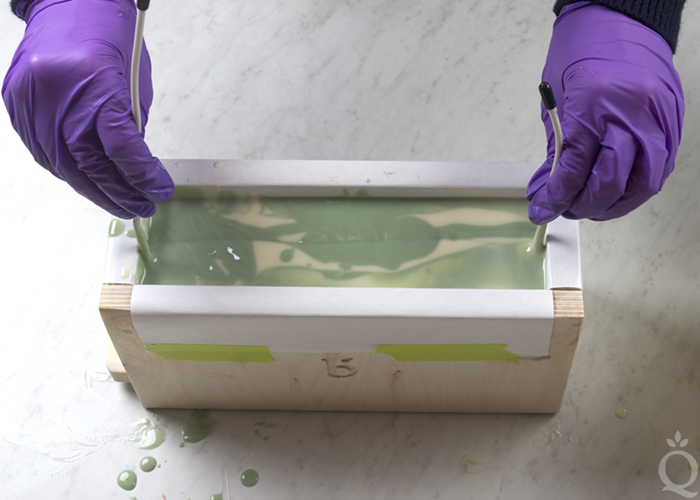
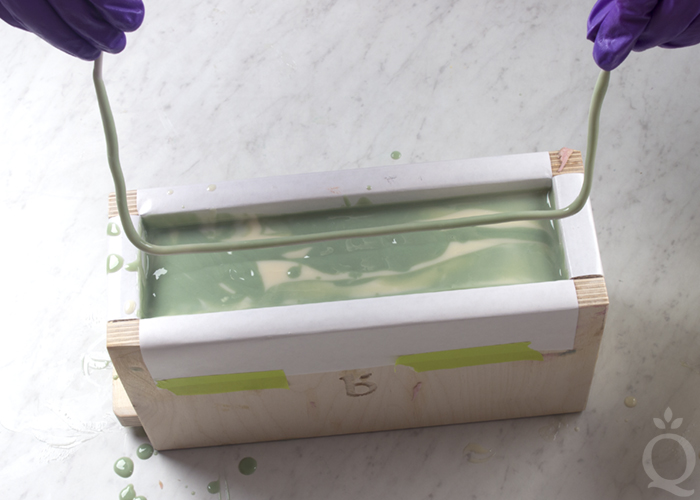 TEN: Pour the leftover white and green soap on top in various lines. Don’t worry about being too precise, just try to make sure an equal amount of each color is showing (that improves the look of the swirl).
TEN: Pour the leftover white and green soap on top in various lines. Don’t worry about being too precise, just try to make sure an equal amount of each color is showing (that improves the look of the swirl).
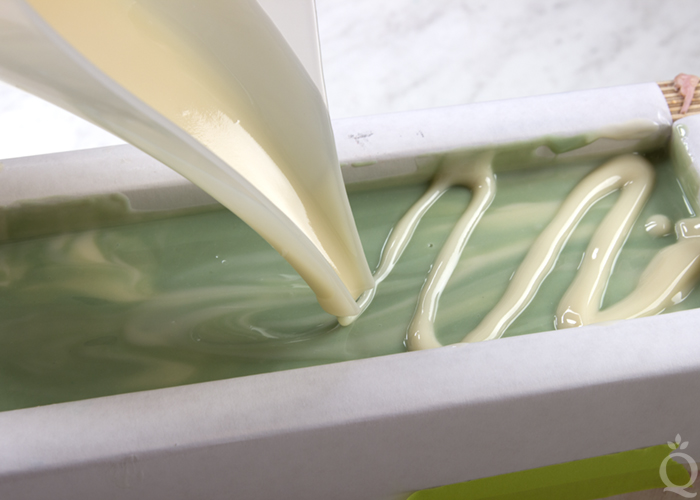 ELEVEN: Insert a dowel or chopstick into the very top of the soap, and move it down the length of the mold while creating figure eights. If you like it more swirled, continue this process until you’re happy with the look.
ELEVEN: Insert a dowel or chopstick into the very top of the soap, and move it down the length of the mold while creating figure eights. If you like it more swirled, continue this process until you’re happy with the look.
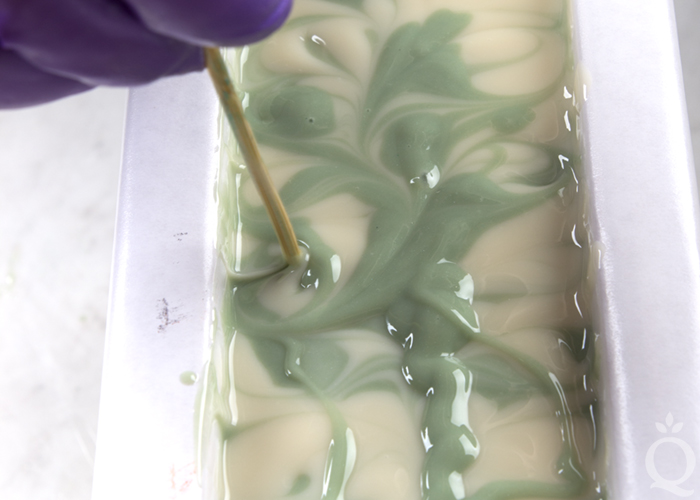 TWELVE: Spritz the top of the soap with 99% isopropyl alcohol to prevent soda ash. Cover the mold with the lid to help insulate the soap and promote a complete gel phase. If you live in a very hot climate, check on the soap every 30 minutes or so to make sure it does not get too hot and crack.
TWELVE: Spritz the top of the soap with 99% isopropyl alcohol to prevent soda ash. Cover the mold with the lid to help insulate the soap and promote a complete gel phase. If you live in a very hot climate, check on the soap every 30 minutes or so to make sure it does not get too hot and crack.
Allow the soap to stay in the mold for about 2-3 days, and unmold. You’ll notice the Kelly Green Mica will have morphed and will appear much brighter. Cut into bars and allow them to cure for 4-6 weeks. Enjoy.
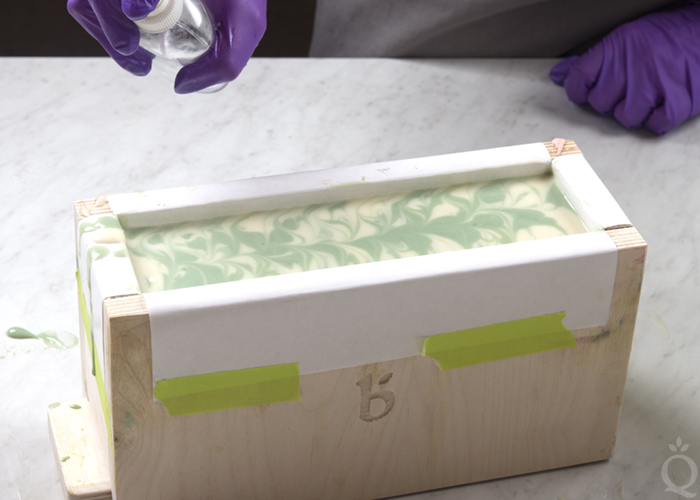
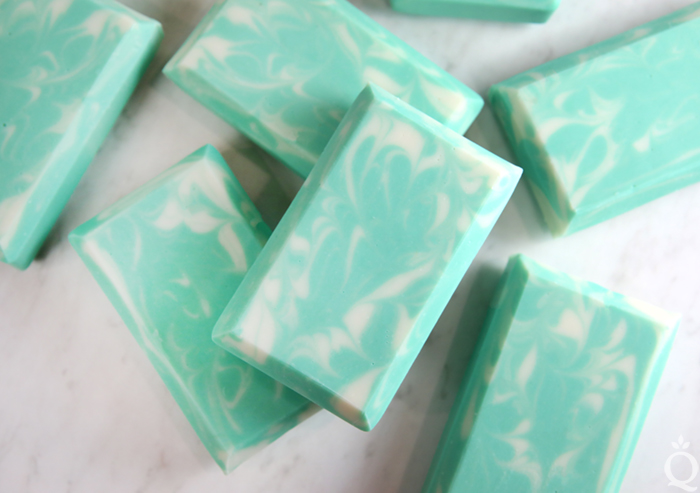
- Tall Narrow Wood Loaf Mold
- Hanger Swirl Tool
- 3.2 oz. Borage Oil (8%)
- 1.2 oz. Castor Oil (3%)
- 10 oz. Coconut Oil (25%)
- 17.6 oz. Olive Oil (44%)
- 8 oz. Palm Oil (20%)
- 5.6 oz. Sodium Hydroxide Lye
- 11.9 oz. Distilled Water (10% water discount)
- 2 oz. Jade Fragrance Oil
- Titanium Dioxide
- Aqua Pearl Mica
- Kelly Green Mica
- Slowly and carefully add the lye to the water and gently stir until the lye has fully dissolved and the liquid is clear. Set aside to cool. If you’d like a harder bar of soap that releases faster from the mold, you can add sodium lactate to the cooled lye water. Use 1 teaspoon of sodium lactate per pound of oils in the recipe. For this recipe, you’d add 2.5 teaspoons sodium lactate.
- Melt and combine the coconut oil, palm oil, olive oil, borage oil, and castor oil (remember to fully melt the entire amount of palm oil before measuring) in a large bowl capable of holding at least 60 ounces. Add 1.5 teaspoons of titanium dioxide powder directly into the oils and use the stick blender to help get rid of clumps. We added the titanium dioxide directly to the oils so we could stick blend out the clumps as much as possible without the trace becoming too thick.
- Once the lye water and the oils have cooled to 130 degrees F or below (and are ideally within 10 degrees of each other), add the lye water to the oils and stick blend until thin trace.
- Add all of the Jade Fragrance Oil to the soap batter and use a whisk to thoroughly mix in.
- Split off about 500 mL of soap into a smaller container. Then add all of the dispersed Aqua Pearl Mica and 1 teaspoon of the Kelly Green Mica to the larger container of soap. Use a whisk to thoroughly mix in the colorants. NOTE: The soap batter should be a thin enough texture to pour but thick enough that the colors don’t completely blend together. If the batter is a little thin, pulse both containers quickly with the stick blender to slightly thicken. Just be careful to not over stick blend.
- Pour some of the green soap into the mold. Then, pour the white soap into the green. Pour the white from several inches above the mold to help the white soap break into the green soap.
- Continue pouring the green and white soap into the mold. The exact amount and placement of each pour is not extremely important. After every few pours, tap the mold on the counter to help get rid of bubbles. Whisk the soap throughout the process to keep it fluid.
- Once the soap is almost all poured into the mold, set aside a very small amount of green and white soap to create a swirl pattern on top.
- Give the mold a firm tap on the counter. Insert the Hanger Swirl Tool into one side of the mold, and begin making loops in the center of the mold. Continue the loop-de-loop motion at varying heights within the mold. This technique is not an exact science. We “looped” the Hanger Swirl Tool about 10 times within the mold. If you like more wispy swirls, feel free to do more loops. This technique is similar to the Butterfly Swirl created by Zahida of Handmade in Florida. See her video here to get a better idea of what that swirling motion looks like. We were much less precise in our swirl for this soap. Remove the Hanger Swirl Tool by pulling up and out along one side of the mold.
- Pour the leftover white and green soap on top in various lines. Don’t worry about being too precise, just try to make sure an equal amount of each color is showing (that improves the look of the swirl).
- Insert a dowel or chopstick into the very top of the soap, and move it down the length of the mold while creating figure eights. If you like it more swirled, continue this process until you’re happy with the look.
- Spritz the top of the soap with 99% isopropyl alcohol to prevent soda ash. Cover the mold with the lid to help insulate the soap and promote a complete gel phase. If you live in a very hot climate, check on the soap every 30 minutes or so to make sure it does not get too hot and crack. Allow the soap to stay in the mold for about 2-3 days, and unmold. You’ll notice the Kelly Green Mica will have morphed and will appear much brighter. Cut into bars and allow them to cure for 4-6 weeks. Enjoy.



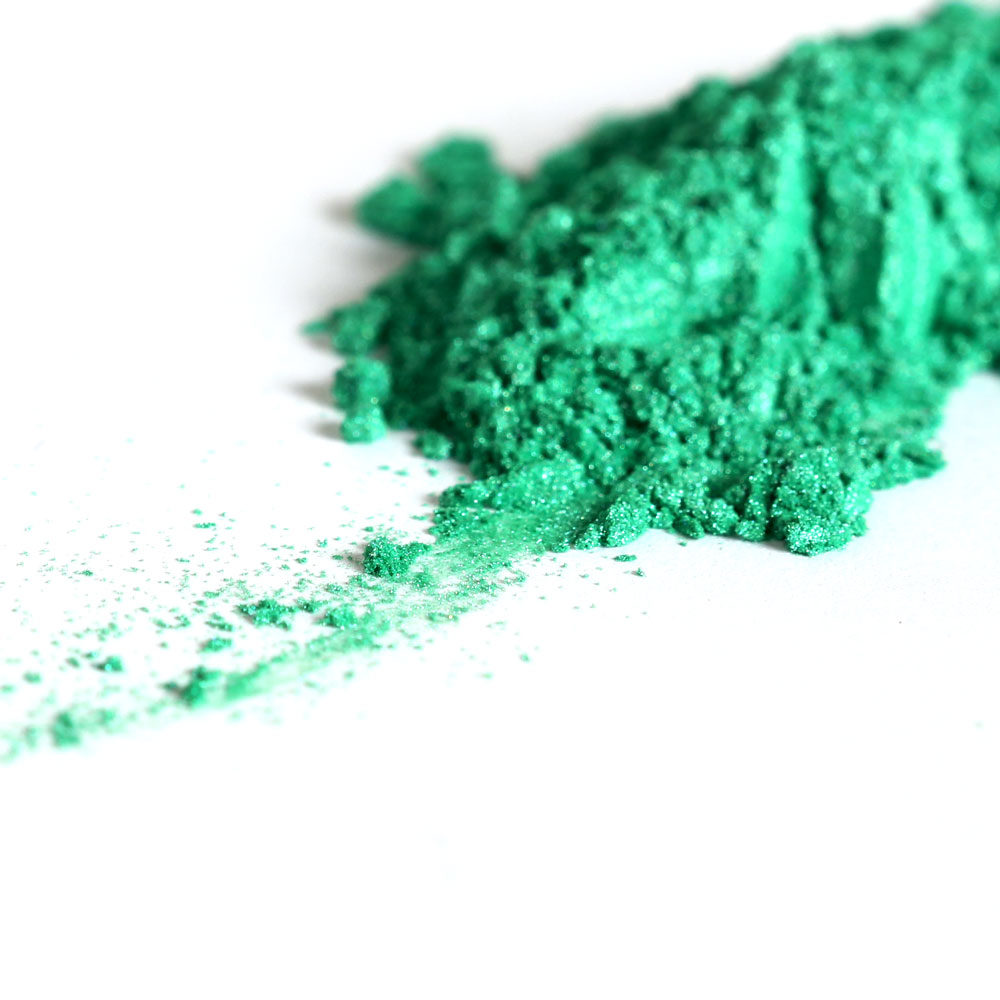
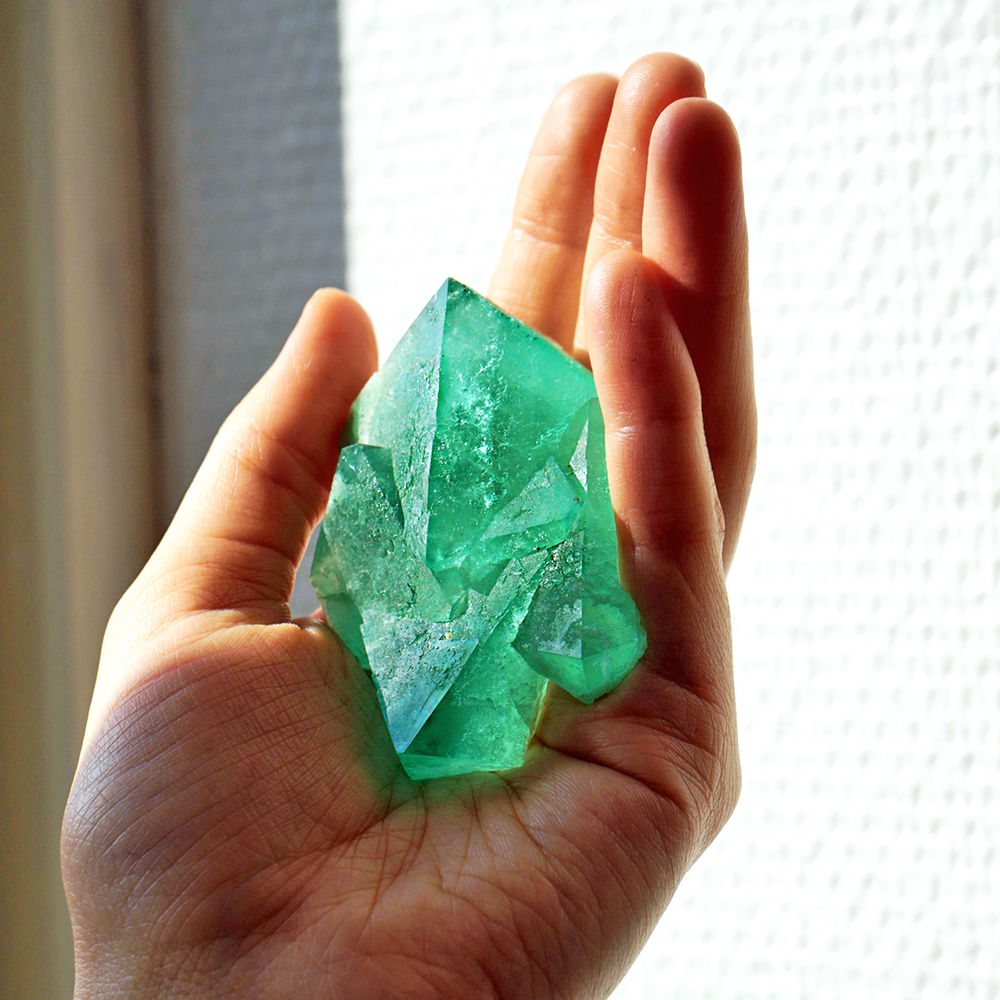
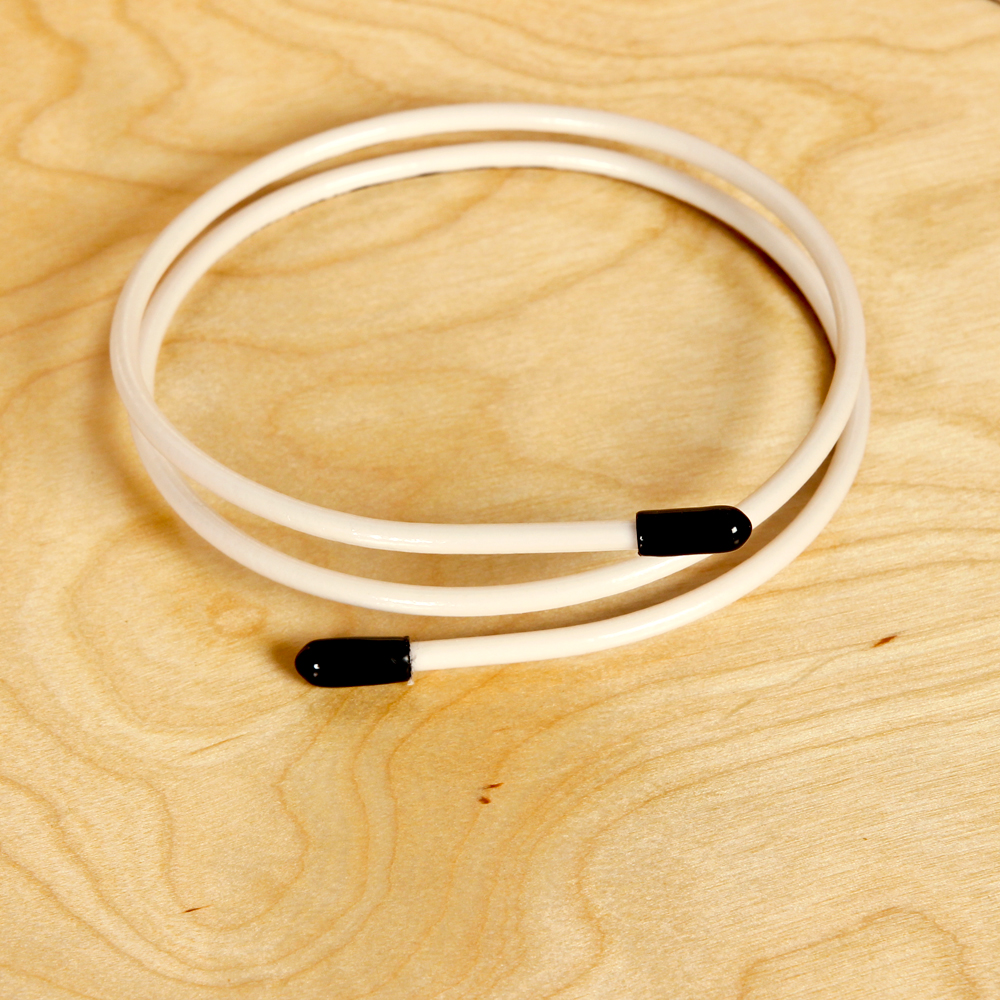


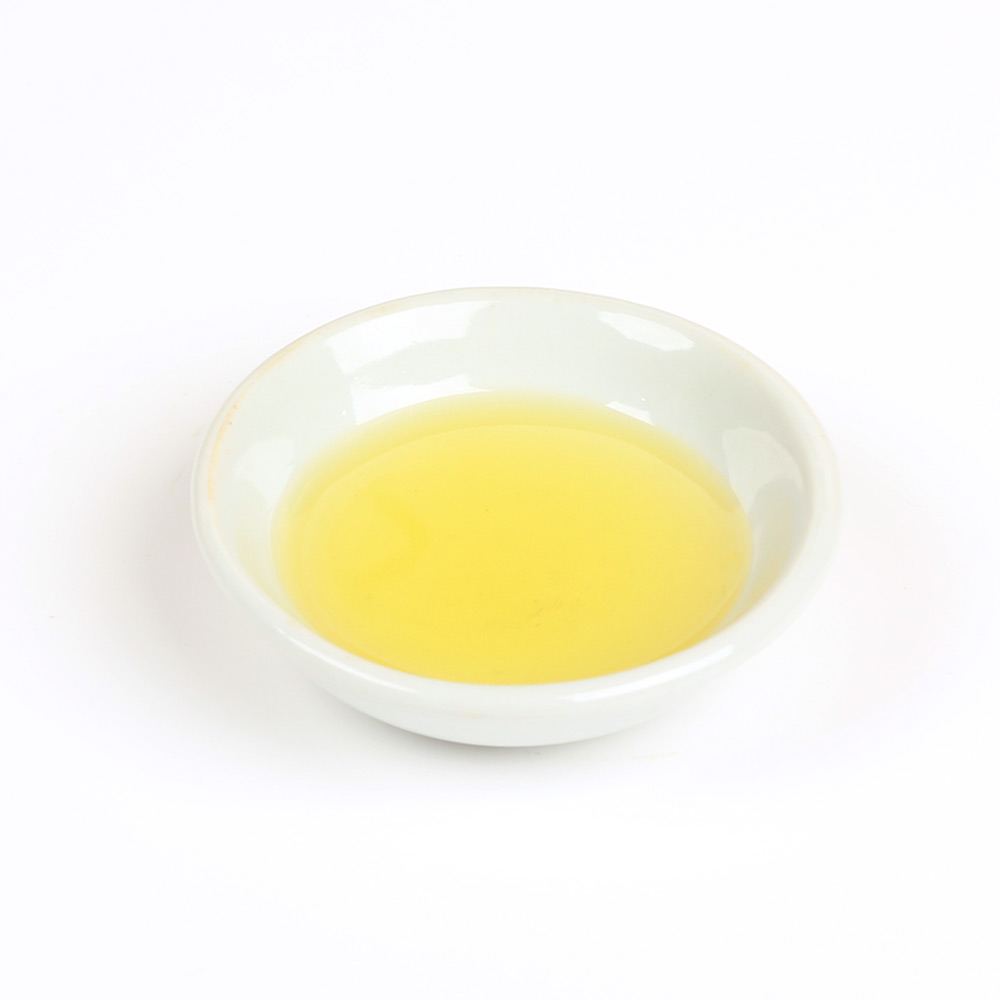
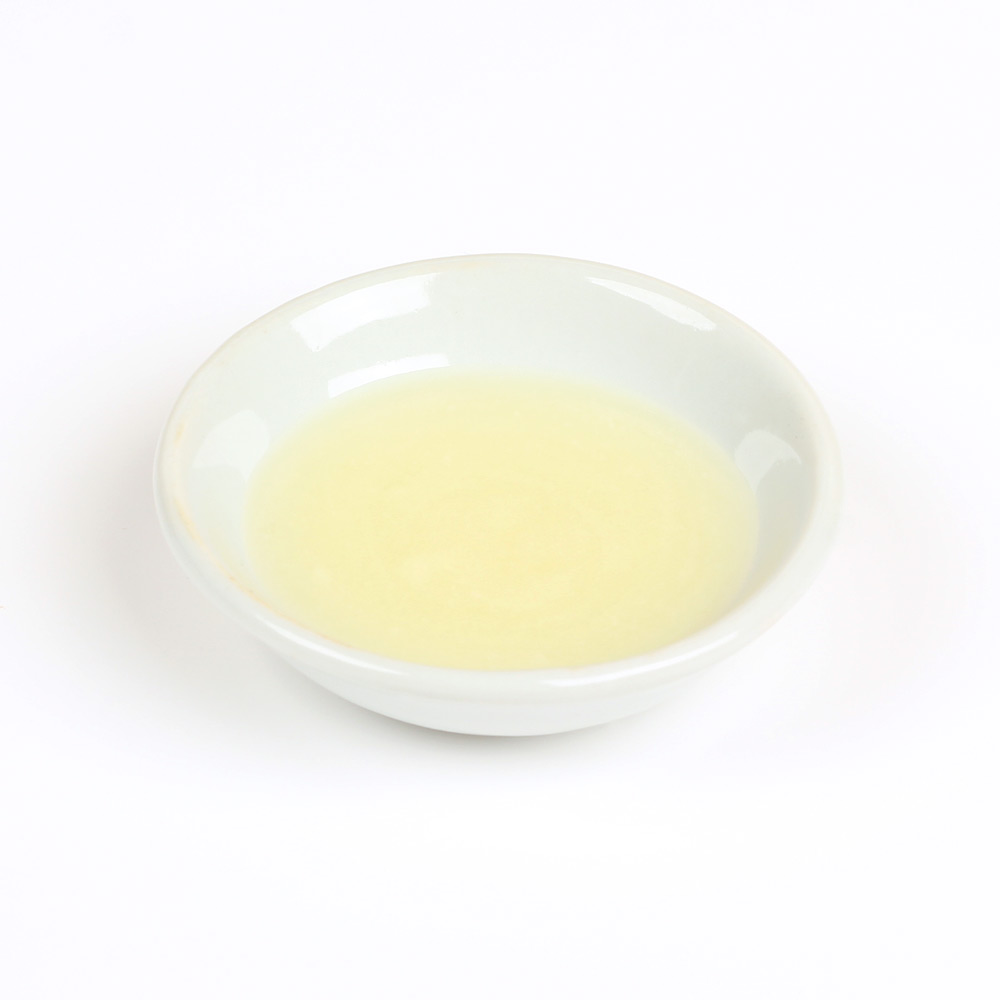


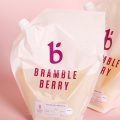
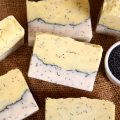

Hi!
I am a soap maker from many years. Ive followed your recipe and added mint essential oil instead of jade fragrance simply because it isn’t available in the country I live in.
Everything went perfectly well. It was curing for 7 weeks. Then Ive wrapped soaps in the plastic foil. And it started to sweat (oily sticky consistency)…. Ive wiped off the liquid and now I keep soap loose in a plastic container. However the dew appeared again on each side of the bars despite being locked in air tight container. Id like to add that I don’t live in humid conditions. Can you please kindly advise if there is any remedy remedy for above issue? Thanks a lot and Regards!
I’m not sure why that’s happening, cold process soap doesn’t usually sweat unless it’s very humid. Did you add anything else to the recipe, like salt?
HI There, Thank you for your response!
Nope – I have followed your recipe very strictly (except switching fragnances). My soap looks exaxtly like yours. I have never came across such phenomena…. Regards!
Have you tried storing the soap on a bakers rack? I’m wondering if there’s still a bit of water in the soap that’s coming out in the container. It may help to store them in an open area that’s cool and dry.
Hi There
I will try to follow your advice. Hope it will help.
Regards!
I am confused.
You state that sunflower oil does not contribute to lather in a soap.
but I have read elsewhere that it does: “Adding or increasing oils that support lather, like almond oil, lard, tallow, cocoa butter, palm oil, shea butter, or sunflower oil.
What is the truth?
Sunflower oil is lightweight, meaning it can help support the lather instead of weighing it down. You can use it with oils like coconut and castor, which add nice bubbles to your soap. Learn more about common oils here: https://www.soapqueen.com/bath-and-body-tutorials/tips-and-tricks/free-beginners-guide-to-soapmaking-common-soapmaking-oils/
This post on formulating cold process recipes is helpful as well: http://www.soapqueen.com/bath-and-body-tutorials/tips-and-tricks/formulating-cold-process-recipes/
Hi,
I live in tropical country, so basically all of our oils are in liquid form except for the butters. I usually let the lye water mix completely cool down before mixing with the oils. Does the temperature affect the final result of the soap? Does it affect gelling phase?
Should I keep the temperature of the lye around 130 degrees? But the difference with the oil will be more than 10 degrees. Please advise 🙂
Temperature does play a big role in soapmaking. What temperature are your oils? As long as they’re fully melted they should be fine to use at room temperature.
Hi,
Can i substitute Borage oil with Olive or Palm oil with the same percentage?
Thanks a lot!
Olive oil will work as a substitute. You can increase the percentage in this recipe to cover the borage oil. Remember to run your recipe through the Lye Calculator again: https://www.brambleberry.com/Pages/Lye-Calculator.aspx
This is lovely! Are there any tutorials for making soaps without Palm Oil? Many people are showing growing concern about using this oil.
Thank you.
Pam
You can replace the palm oil with babassu oil. You can use the same amount as the palm oil, just make sure to run your recipe through the Lye Calculator after any substitutions: https://www.brambleberry.com/Pages/Lye-Calculator.aspx
Babassu oil: https://www.brambleberry.com/Babassu-Oil–P6807.aspx
You can add certain oils and butters to add the firmness palm oil does. For instance, adding a hard butter, like cocoa butter up to 15%, can harden the bars. You can also add coconut oil or tallow up to 33%.
Read more about common oils and what properties they add to soap here: http://www.soapqueen.com/bath-and-body-tutorials/tips-and-tricks/free-beginners-guide-to-soapmaking-common-soapmaking-oils/
This post on substituting oils has some great information too: http://www.soapqueen.com/bath-and-body-tutorials/tips-and-tricks/how-to-substitute-oil-in-cold-process-recipes/
Sodium lactate is helpful as well. It helps the bars unmold more quickly. You can add 1 tsp. of sodium lactate per pound of oils to your cooled lye water. Read more in the Sunday Night Spotlight: Sodium Lactate: http://www.soapqueen.com/bramble-berry-news/sunday-night-spotlight-sodium-lactate/
Here are some links to palm-free recipes you may like:
Palm Free Vertical Twist: http://www.soapqueen.com/bath-and-body-tutorials/cold-process-soap/palm-free-vertical-twist-tutorial/
Palm Free In The Pot Swirl: http://www.soapqueen.com/bath-and-body-tutorials/cold-process-soap/a-palm-free-in-the-pot-swirl/
Formulating Cold Process Recipes: http://www.soapqueen.com/bath-and-body-tutorials/tips-and-tricks/formulating-cold-process-recipes/
Thank you for the links! Perhaps with 25% coconut oil in this recipe the babassu would not be a good substitute. I’ll check the links thank you!
Very nice! Before I knew about brambleberry or soapqueen, I discovered the drop swirl by accident and loved it. Then I added the hanger swirl and loved it. I thought I was onto something! Then, I discovered both techniques combined on the internet. Somebody beat me to it! I still love the combination of the two and I just made one last week. Thanks for the post! Youtube.com under the soap man and no ads.
The drop and hanger swirl are such a pretty combination. We’ll check out the video, thanks for sharing.